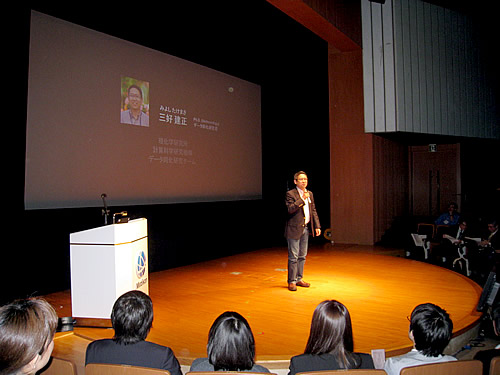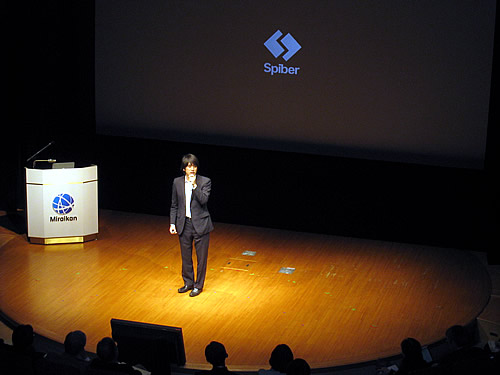世界を変える研究をしている人たちは、どのような道のりで今に至っているのでしょうか。アゴラキーノートセッション4では、それぞれ豪雨の予測と、クモの糸の人工合成に取り組んでいる2名のトップイノベーターから、革新的な研究をするための信念が語られました。また、スーパーサイエンスハイスクール(SSH)や未来の科学者養成講座、世界的な科学コンテストの参加経験のある大学生と大学院生が、中高生に向けて熱いメッセージを送りました。
There are people who are engaged in research projects that can potentially change the world. What kinds of paths did they take to get to where they are now? In Agora Keynote Session 4, two top innovators engaged in torrential rain forecasting and the artificial synthesis of spider silk talked about the beliefs which led to their innovative research. Also, university undergraduate and postgraduate students who have participated in Super Science High Schools (SSH), training courses for future scientists and global science competitions gave words of encouragement to junior high school and high school students.
このセッションには、多くの中高生が登壇者の話を聴きに参加しました。登壇するトップイノベーター2名が若く、また現役の大学生、大学院生がパネルディスカッションを行うということで、より身近な研究者に接することができるセッションとなりました。
In the session, many junior high school and high school students joined the audience in order to listen to the speakers. This session offered them an opportunity to meet researchers that they can relate to more easily, because the two top innovators who spoke at the session were young and also undergraduate and postgraduate students had a panel discussion.
「雨雲の立体構造を詳細に観測できる最新鋭のレーダーと、高度なシミュレーションができるスーパーコンピュータ『京』を組み合わせて、未来の天気予報を創造する。突然の豪雨も予測できるだろう」。こう話すのは、理化学研究所計算科学研究機構データ同化研究チーム・チームリーダーの三好建正氏です。研究チーム名にあるデータ同化とは、観測データとシミュレーションを結びつけることで、シミュレーションの精度を高めること。三好氏は、高性能レーダーから得られるデータと、スーパーコンピュータ『京』を組み合わせ、これまでにない精度で雲の動きを再現したり、局所的な天気の変化をとらえたりすることを研究の目的にしています。「イノベーティブなものを組み合わせて、さらなる価値を生み出す」と強調します。
Takemasa Miyoshi, Team Leader of the Data Assimilation Research Team at the RIKEN Advanced Institute for Computational Science explained that a weather forecast system can be created by combining state-of-the-art radar which enables the detailed observation of the structure of rain clouds in three dimensions and the “K computer” supercomputer which enables advanced simulations. He added that this would enable the accurate prediction of sudden torrential rain. The term “data assimilation” used in the team’s name means increasing the accuracy of simulations by incorporating observation data into simulations. The objective of Dr. Miyoshi’s research is to replicate the movement of clouds more accurately than has never been achieved before and to identify localized changes in the weather, by combining the data obtained by high performance radar and the K computer. He emphasized that he creates value by combining innovations.

三好氏は、2000年に京都大学理学部を卒業後、気象庁に入庁し、2年間総務業務に従事します。しかし、どうしても研究に携わりたくなり、人事院行政官長期在外研究員制度を利用した留学を目指します。「どれだけ遅くに帰っても、英語は毎日勉強した」と、当時の苦労を振り返りながら話しました。
After graduating from the Faculty of Science, Kyoto University in 2000, Dr. Miyoshi found job at the Japan Meteorological Agency(JMA) and worked on administrative affairs for two years. However, he became eager to engage in research and decided to try studying abroad using the National Personnel Authority Long-term Overseas Fellowship Program. He looked back at his struggles then and said that he studied English every day regardless of how late he went home.
留学先のメリーランド大学では、寝る間を惜しんで勉学に励み、2年間で博士号を取得しました。この2年という期間は、メリーランド大学で博士号を取得した学生のなかでは最短記録だそうです。
At the University of Maryland where he was admitted as an international student, he studied hard and received a doctorate in two years. This is the shortest period recorded for a student to receive a doctorate from the University of Maryland.
気象庁に戻ってからは技術開発に注力し、2008年に気象学の若手研究者の栄誉とも言える山本・正野論文賞を受賞。気象庁で最先端の技術開発に携わっていくなかで「研究者として目覚めた」と語り、気象庁を離れて、メリーランド大学で助教授として世界をリードする研究に打ち込むことになりました。
After returning to the JMA, Dr. Miyoshi focused on technological development and received the Yamamoto-Syono Award for Outstanding Papers in 2008, which is an honor given to young researchers in meteorology. He explained that working on the state-of-the-art technological developments at the JMA made him become determined to pursue his career as a researcher. He left the JMA and concentrated on world-leading research projects as an assistant professor at the University of Maryland.
その後、スーパーコンピュータ「京」の存在を知り、「京」を使いこなした研究をするために、現在の理化学研究所に研究の場を移しました。「理化学研究所では、研究のみに集中できる環境がある。この環境で気象学を究め、人類に貢献したいと考えている」と話します。さらに「研究にはお金はかかる。しかし、その研究費以上の価値を生み出すと断言できる研究しかしない」と述べ、世界最先端の研究を通じて、極みを目指していくステージにいると三好氏は考えています。
Later, Dr. Miyoshi heard about the K computer and moved to RIKEN where he currently works, in order to make full use of the K computer in his research. He said that the environment provided by RIKEN allows him to concentrate solely on research and that he would like to use this environment to devote himself to meteorology and contribute to humanity. He also said that research costs money and that he would only engage in research which he can confidently say would create value that exceeds the research costs. Dr. Miyoshi considers that he is at the stage where he should aim for the summit through the world’s state-of-the-art research.
中高生に向けて「研究者になるのであれば、英語は大事。自分の言いたいことを英語で伝えられるように」「将来のことはわからないが、夢や希望、想いは人に話すべき」とアドバイス。さらに「サイエンスが楽しいから研究をしている。最先端の研究をしていても、モチベーション(動機)やパッション(情熱)が原点になる。サイエンスを楽しいと思うことは大事」と呼びかけました。
Dr. Miyoshi advised junior high school and high school students that English is important if they want to become researchers and that they should become able to communicate their opinions in English. He also advised them to talk about their dreams, hopes and ideas to others even though we do not know what the future will bring. He also said to the students, “I do research because science is fun. Even state-of-the-art research originates from motivation and passion. It is important that you enjoy science.”
次に登壇したのは、スパイバー(株)取締役兼執行役の菅原潤一氏。菅原氏が取り組んでいるテーマは、人工クモ糸の量産・活用です。クモの糸は、この世で最も強い糸であると言われています。理論上は、直径1cmのクモの糸で巣を張ればジェット機もキャッチできるほどです。「クモの糸を使えば、転んでも擦り切れない服だけでなく、より軽量で丈夫な自動車部品や、人工血管などの開発にも応用できる」と話します。
Junichi Sugahara, Executive officer of Spiber Inc. gave a speech following Dr. Miyoshi. Mr. Sugahara works on the themes of the mass production and utilization of artificially synthesized spider silk. Spider silk is known to be the toughest material on earth. Theoretically, a spider’s web made of spider silk which is 1 cm in diameter could stop a jet airplane. Mr. Sugahara said, “Spider silk can be used to produce clothes that cannot be torn even if you fall over in them. It can also be used to develop lighter and more durable auto parts as well as artificial blood vessels.”

しかし、クモは肉食動物のため家畜化が難しく、クモの糸を大量に調達できないという欠点があります。その欠点を解決するため、クモの糸を作る遺伝子を人工合成し、微生物に組み換えることでクモ糸を作らせることに成功したのが、菅原氏を始めとするスパイバーの創業メンバーです。スパイバーは、2013年に、世界で初めて合成クモ糸繊維の量産化を実現したとして、大きな注目を浴びています。社名は、スパイダー(spider: クモ)とファイバー(fiber: 繊維)の組み合わせに由来します。
However, spider silk has a disadvantage. It cannot be procured in large quantities because spiders are predators that cannot be farmed. In order to overcome this disadvantage, the founders of Spiber Inc. including Mr. Sugahara successfully synthesized the genes for producing spider silk fibroin proteins and incorporated them into microbes, which then produced the artificial protein material. Spiber Inc. has gained much attention as a company which achieved the world’s first mass production of synthesized spider silk fiber in 2013. The name of the company is an incorporation of the words “spider” and “fiber.”
菅原氏がこのような道を歩むきっかけとなったのは、大学で起業に興味をもつ先輩(注:スパイバー(株)取締役兼代表執行役 関山和秀氏)との会話からでした。この世で最も強い虫は何か、という他愛もない話からクモの糸の話題となり、仲間と独自にクモ糸の合成研究を始めました。研究開始から3年後にクモ糸の合成に成功したものの、ほこりのような小ささで、本当にクモ糸なのか疑う声もあったそうです。当時の菅原氏は、誰が見てもクモの糸だとわかるくらいのものを作ってから起業しようと考えていました。「ところが先輩は違った。誰もが無理だと思っている今だからこそ勝ち目がある、と。ベンチャー企業は、賭けに出ないといけないときがある」(菅原氏)。賭けには勇気が要りますが、信頼できる仲間がいたからこそ起業できたと、菅原氏は振り返りました。
Mr. Sugahara started to work on this theme after he had a conversation with a student in a higher grade at his university who was interested in starting up a business (note: Kazuhide Sekiyama, Representative Executive Officer of Spiber Inc.). The conversation started from a general topic like what is the strongest bug in the world. They then moved on to talking about spider silk, and it motivated them along with others to start independent research into the synthesis of spider silk. Although they succeeded in synthesizing spider silk three years after the research started, it was as small as dust and some people doubted if it really was spider silk. At the time, Mr. Sugahara thought that they should start up a business after succeeding in producing spider silk that was big enough for everybody to see that it was indeed spider silk. “However, my colleague that I mentioned before said otherwise. He said that we should start up a business right away because nobody has achieved mass spider silk production. A venture company has to take chances sometimes,” Mr. Sugahara said. He looked back and said that, although taking a chance requires courage, he was able to jump in because he had colleagues that he trusted.
起業直後は、公的機関の助成金を受けるも足りず、学生ながら自分たちの資金をつぎ込み、実験に必要な環境を整えるのにやっとの日々であったとのこと。最初はわずか1本、数cmしかできなかったクモ糸は、やがて長く、大量に安定して合成できるようになり、投資家からの支援も増えていきます。現在の従業員は約70名。基盤技術を開発したいま、スケールアップ研究と製品開発を行うための拠点として、年間10トンの生産能力を持つ工場を立ち上げました。
Mr. Sugahara said that, immediately after the business startup, the subsidy they received from the local government was not enough and they just about managed to create the environment needed for experiments by investing their own money although they were still students. Initially, they were only able to make one spider silk thread which was only a few centimeters long, but they eventually succeeded in synthesizing a large quantity of long spider silk threads stably and started to receive increasing support from investors. They currently have about 70 employees. As they had developed the basic technology, they established a factory with a production capacity of 10 tons per year, as a center for scaling-up the research and product development.
クモ糸の量産という、不可能に思われたことを実現できたのは、なぜでしょうか。菅原氏は、合成における工程を分業化せず、全体を見渡すことがポイントだと強調します。「幅広い技術を組み合わせることが重要。組み合わせることで、新しいアイデアや問題点を見つけることができる」(菅原氏)。
How did they manage to achieve the mass production of spider silk which was believed to be impossible? Mr. Sugahara emphasized that seeing the whole picture rather than dividing the synthesizing process is key. “Combining a wide range of technologies is important. Through combining them, you can find new ideas and new problems,” Mr. Sugahara said.
革新的な研究をするために必要なものとして、熱い思い、人との出会い、転機を逃さないことであると、菅原氏は話します。さらに、次のようにも述べています。「実は、大学に入ったとき、生物は好きではなかった。しかしバイオテクノロジーを使えば、石油の枯渇やウイルス感染、食糧不足など、多くの問題を解決できると知り、この道に進んだ。大切なのはモチベーションだ」(菅原氏)。
Mr. Sugahara said that innovative research needs passion, meeting the right people and the will to seize opportunities. He also added, “Actually I did not like biology when I entered the university. However, I learned that biotechnology can solve many problems including the exhaustion of oil, viral infections and food shortages. That’s why I decided to work on this theme. Motivation is important.”
後半では、スーパーサイエンスハイスクール(SSH)や未来の科学者養成講座、世界的な科学コンテストの参加経験がある大学生と大学院生4名が登壇。それぞれがいま打ち込んでいる研究や活動について講演形式で紹介した後、パネルディスカッションに移行。自然科学研究機構特任准教授の松山桃世氏のファシリテーションのもと、これまでの科学研究体験や研究と社会の関わり、今後の展望などについて熱く語りました。
In the latter half of the session, speeches were given by four university undergraduate and postgraduate students who have participated in Super Science High Schools (SSH), training courses for future scientists and global science competitions. Each of them gave a lecture on the research and other activities that they are currently engaged in, before moving on to a panel discussion. They had heated discussions about their experiences in scientific research and the connection between research and society, as well as on their prospects for the future. The discussions were facilitated by Momoyo Matsuyama, Project Associate Professor at the National Institutes of Natural Sciences (NINS)

例えば、日本と海外とで高校生が行う研究の違いについて、東京大学大学院の三浦拳氏は「日本では、コンテストの審査員に中学校や高校の教諭や大学教授が多く、教育視点で見られている。しかし海外では、ノーベル賞受賞者やスポンサー企業が審査し、実用性について詳しく質問される」と話します。また、早稲田大学の宇山慧佑氏は「海外の研究発表では、研究者と同じレベルが求められる。また、限られた審査時間のなかで、自分の研究の強みをアピールすることが大切」と答えました。
さらに、英語との関わりについて話が及びました。「研究に必要な情報は、海外機関のウェブサイトに直接アクセスして取得する」(伊藤氏)と研究を進めていく上での英語の必要性に触れたほか、「大学の研究室は留学生が多く、ミーティングは英語で行う」(三浦氏)と日常の研究現場でのコミュニケーションツールとしても英語が重要であることを強調しました。
For example, regarding the difference between research projects conducted by high school students in Japan and overseas, Ken Miura from a graduate school at the University of Tokyo explained, “In Japan, many of the judges for competitions are junior high school teachers, high school teachers and university professors. They judge projects from an educational standpoint. In other countries, Nobel-prize winners and corporate sponsors judge projects and ask about their practical use in detail.” Keisuke Uyama from Waseda University said, “In other countries, the presentations of papers by students are expected to be of the same quality as those of researchers. It is also important to be able to emphasize the advantages of your research project in the limited examination time.”
The discussions extended to the use of English in research. Chieko Ito from Keio University mentioned the need for English when conducting research by saying that she obtains the information needed for her research by directly accessing the websites of overseas institutions. Mr. Miura emphasized the importance of English as a communication tool for daily research activities by saying that there are many international students at university laboratories and meetings are conducted in English.
また、科学に対する原動力として、好奇心に根ざしたものか、実用化を意識したものか、ということは常に議論されます。このことについては、大阪大学の中森祐未氏は「自分は好奇心だけで動いている」と答えた一方で、「きっかけは好奇心だが、技術は人の役に立ってこそ」(三浦氏)という意見も出ました。慶應義塾大学の伊藤千慧子氏は「好奇心でやっているが実用化も意識している」と話し、「自分の研究の位置付けがしっかりできていれば、どちらでもよいのでは」(宇山氏)という考えも出ました。
There are constant discussions about whether scientific research should be driven by intellectual curiosity or take into account practical use. In this panel discussion, Yumi Nakamori from Osaka University said that she is driven solely by curiosity, while Mr. Miura said that a technology has value if it is useful for people, although his initial motivation is curiosity. Ms. Ito said that she takes practical use into account, although she does research out of curiosity. On the other hand, Mr. Uyama said that either way is good as long as you know what the purpose of your research is.
パネルディスカッションが終盤に差しかかったところで、会場からの質問を受け付けました。科学研究を志している中高生からは、「実験や研究で壁にぶつかったとき、困難をどう乗り切るか」という質問が出ました。「笑顔で乗り切る。笑っていれば誰かが助けてくれるし、気分が沈んでいくと結果も悪くなる」(中森氏)というユニークな答えが飛び出すなかで、「困難なときこそ研究の本質に迫っているときであり、根気よく考え抜くことが求められる。同時に、一歩引いて、解決すべき問題であるかも見極めた方がよい」(宇山氏)と、会場が頷く場面もありました。
Near to the end of the panel discussion, the audience was invited to ask questions. One of the school students who wishes to become a scientific researcher asked the panelists how they get through difficulties when their experiment or research becomes deadlocked. Ms. Nakamori gave a unique answer, “I get through difficulties with a smile. Somebody will give you a helping hand if you have a smile. Feeling low will only give you bad results.” The audience nodded when Mr. Uyama said, “You are getting to the heart of the research topic when you face difficulties. You should be patient and think it through. It is also important for you to step back and examine whether it is a problem you need to solve.”
下記のリンクからご覧ください。